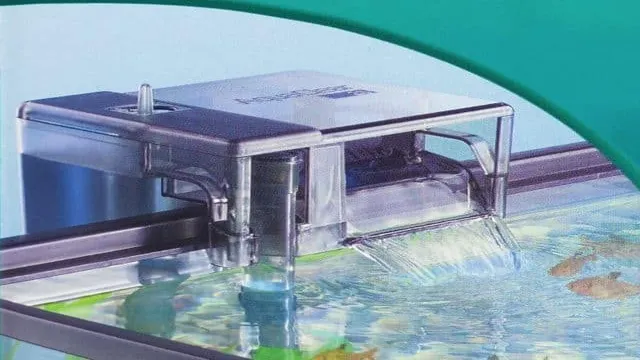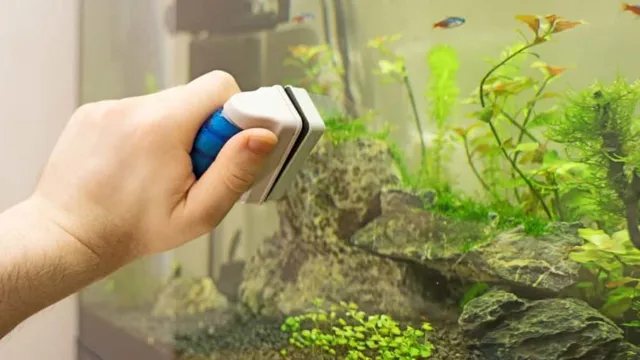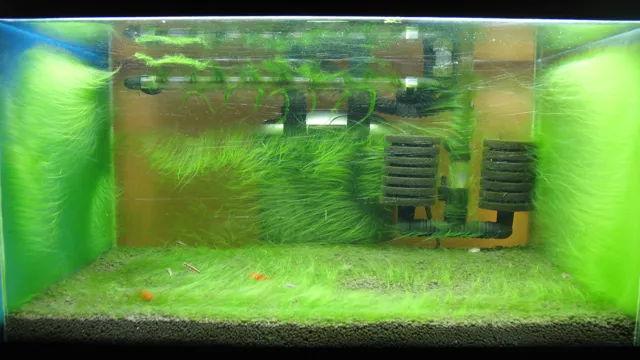How to Large Public Aquariums Filter Water: Top Techniques to Ensure Aquatic Life Thrives

Have you ever visited a public aquarium and marveled at the vibrant marine life on display? The serene ambiance and stunning visuals all come together to create a peaceful oasis within the concrete jungle. However, have you ever stopped to wonder about how the massive tanks of water are kept clean and healthy for its aquatic residents? It’s not Magic, but rather expert filtration systems that ensure that the water remains crystal-clear and free from contaminants. In this blog, we will be focusing on how large public aquariums filter their water to provide a healthy environment for the marine life that calls it home.
So buckle up and let’s dive into the world of aquatic filtration!
Understanding Water Filtration in Aquariums
Proper water filtration is an essential aspect of maintaining a healthy and thriving aquarium. Large public aquariums typically have sophisticated filtration systems that are capable of handling vast amounts of water. These systems operate by utilizing different types of filters that work in tandem to remove impurities from the water.
The mechanical filter physically removes large debris, such as fish waste and leftover food, while the biological filter utilizes beneficial bacteria to break down organic material. Finally, the chemical filter removes microscopic impurities, including toxins and chemicals. By combining these three types of filtration, public aquariums can maintain clean and clear water, allowing visitors to see the animals and organisms that call the aquariums home.
Overall, proper water filtration is crucial to the health and well-being of aquatic life in aquariums, and its importance should not be overlooked.
Importance of Filtration in Aquariums
Water filtration is a vital component of any aquarium as it helps maintain the water quality, ensuring a healthy environment for your fish and aquatic plants. However, understanding the filtration process can be overwhelming for beginners. In simple terms, filtration involves passing water through mechanical, biological, and chemical filters to remove debris, impurities, and harmful toxins.
The mechanical filter physically traps large particles, while the biological filter uses beneficial bacteria to break down organic waste. Finally, the chemical filter removes dissolved impurities such as ammonia, nitrates, and phosphates. In combination, these filters work to create a balanced and healthy aquatic ecosystem.
The key to proper filtration is choosing the right type of filter for your aquarium’s size and inhabitants and regularly maintaining it. Remember, a well-maintained filtration system is crucial for the overall health and longevity of your aquatic residents. So don’t underestimate the importance of proper filtration in your aquarium!

Types of Filtration Methods
Water filtration in aquariums can be achieved through various methods. One of the most popular is mechanical filtration, which works by physically trapping debris and waste particles as water passes through a filter medium. Another commonly used method is biological filtration, which utilizes bacteria to break down harmful toxins in the water, converting them into less toxic substances.
Chemical filtration is another option, and involves using activated carbon or other specialized filter media to remove impurities from the water. Each filtration method serves a unique purpose and can be used in different combinations to achieve optimal water quality. It is important to choose the right type of filtration for your aquarium based on the specific needs of your aquatic environment and the type of animal species you keep.
By maintaining adequate filtration, you can ensure a healthy and thriving aquatic ecosystem for your fish and other aquatic animals to live in.
Factors to Consider When Choosing Filtration System
When it comes to maintaining a healthy and thriving aquarium, one of the most important factors to consider is the filtration system. Understanding the basics of water filtration in aquariums can help you choose the right filtration system for your needs. A high-quality filtration system helps to remove harmful waste, debris, and toxins from the water, promoting a healthy and stress-free environment for your fish and other aquatic creatures. (See Also: How to Anchor Mangrove Plants in Marine Aquarium: Step-by-Step Guide)
When choosing a filtration system for your aquarium, consider factors such as the size of your tank, the type and number of fish you have, and the types of pollutants you want to remove from the water. With the right filtration system in place, you can enjoy a clean and clear aquarium that promotes the health and well-being of your aquatic pets.
Filtration System Components and Their Functions
If you’re wondering how large public aquariums filter water to keep their tanks clean and healthy for marine life, you’re in the right place. One essential component of a filtration system is the mechanical filter, which uses a device such as a sponge or filter floss to physically trap debris and waste particles. Another important part is the chemical filter, which uses activated carbon to remove impurities and pollutants from the water.
The biological filter is also crucial as it provides a habitat for beneficial bacteria that break down harmful substances and convert them into less harmful ones. Additionally, a protein skimmer is often used to remove organic compounds from the water’s surface. A UV sterilizer can also be employed to expose the water to radiation that destroys harmful bacteria and microorganisms.
All these components work together to maintain ideal water conditions in the aquarium, ensuring the health and wellbeing of the marine life in it. So, the next time you visit a large public aquarium and marvel at its pristine aquatic environment, now you know how it’s achieved.
Mechanical Filtration
Mechanical filtration is a critical component of any filtration system, and there are a variety of filters that can be used to effectively remove impurities from water. These filters work by physically trapping suspended particles, sediment, and debris as water passes through them. The filter media used can vary depending on the specific application, from sand and gravel to activated carbon.
One of the most common types of mechanical filters is a sediment filter, which is designed to remove small particles that can clog pipes and appliances. Another essential component of mechanical filtration is the filter housing itself, which is designed to protect the filter media and ensure efficient water flow. By combining mechanical filtration with other types of filtration, such as biological or chemical filtration, it is possible to create a comprehensive system that effectively removes a wide range of contaminants from water.
Overall, mechanical filtration plays a crucial role in maintaining the quality and safety of our water supplies.
Biological Filtration
When it comes to a biological filtration system, there are different components that work together to eliminate harmful substances in an aquarium or pond. The most crucial component is the filter media, which provides a surface area for beneficial bacteria to grow and convert toxins into less harmful substances. Another essential component is the pump, which circulates water and ensures that all areas of the filtration system are equally treated.
The airstone also plays a role by increasing oxygen levels and encouraging the growth of aerobic bacteria. Additionally, mechanical filtration components such as sponges or cartridges remove debris and particles from the water column before they can clog the biological media. All of these components work in harmony to create a healthy and thriving aquatic environment for its inhabitants.
By understanding the functions of each component in a filtration system, aquarists and pond owners can maintain the optimal conditions for their aquatic ecosystems.
Chemical Filtration
Chemical filtration is an important component of any aquarium setup, responsible for removing harmful chemicals from the water. The most important chemical filtration system components are activated carbon, ion exchange resins, and zeolite. Activated carbon is a highly porous material that absorbs impurities and toxins, such as chlorine, medications, and heavy metals. (See Also: How to Cycle a New Saltwater Aquarium in 7 Easy Steps – A Beginner’s Guide)
Ion exchange resins work by exchanging ions with contaminants, effectively removing them from the water. Zeolite is a porous mineral that selectively removes ammonia from the water. The combination of these filtration components is crucial in maintaining good water quality and a healthy aquatic environment for your fish and plants.
It is important to always monitor the effectiveness of your chemical filtration system to ensure that it is functioning properly and efficiently. By routinely replacing old filtration media with fresh media and performing regular water changes, you can keep your aquarium water crystal clear and free from harmful chemicals.
Best Practices for Maintaining Water Filtration System
Large public aquariums require a robust and efficient water filtration system to maintain the health and well-being of the marine life residing there. To keep the filtration system running smoothly, there are several best practices that aquarium staff should adhere to. Firstly, regular cleaning and maintenance of the filters and strainers are essential.
This ensures that debris and waste are removed swiftly and efficiently, reducing the risk of clogged filters and reduced water flow. Secondly, water quality testing should be conducted periodically to ensure that the filtration system is removing impurities and toxins effectively. If water parameters are outside of acceptable ranges, adjustments should be made to the system.
Thirdly, aquarium staff should avoid overfeeding the marine life. Excess food not consumed by the marine animals can lead to an accumulation of waste, compromising water quality. By following these best practices, public aquariums can maintain a healthy and sustainable environment for their marine life to thrive in.
Regular Cleaning and Maintenance
Regular cleaning and maintenance are integral to ensuring the efficient functioning of your water filtration system. To start, it is crucial to change your filters periodically. Depending on the type of filter, they can get clogged or saturated, which can lead to poor water flow, a decrease in filtration efficiency, and even damage to the system.
Additionally, clean and sanitize the system including the tank, valves, and tubing. Failing to perform proper cleaning can result in bacteria growth that can compromise the water quality. Also, keep an eye out for signs of leaks or damage, and have your system inspected regularly by a professional to catch any issues early.
Taking regular maintenance steps can help you get the most out of your water filtration system and provide clean, safe drinking water for you and your family.
Monitor Water Parameters
Maintaining a water filtration system is essential for ensuring clean and safe water for everyday use. One of the best practices for keeping your filtration system in top condition is by monitoring water parameters regularly. This includes checking the pH level, total dissolved solids (TDS), chlorine levels, and turbidity.
By monitoring these parameters, you can identify any changes that may indicate a problem with the system, such as the need for a filter replacement or maintenance. Additionally, keeping track of water parameters can help you identify any ongoing issues with the water source, allowing you to take necessary steps to address them. By making sure your water filtration system is working efficiently, you can enjoy clean and safe water with peace of mind.
Conclusion and Final Thoughts
In summary, filtering the water in a large public aquarium is a fin-tastic feat that requires a careful balance of technology, science, and marine animal welfare. From mechanical filtration to biological filtration, the aquarium staff must maintain a clean and safe environment for their underwater inhabitants. It’s a complex system that’s both awe-inspiring and essential, ensuring that we can all enjoy the beauty and wonder of the ocean without ever leaving the city. (See Also: How to Make a Small Saltwater Aquarium: A Beginner’s Guide to Setting up a Nano Reef Tank)
So next time you’re wandering through a mesmerizing aquarium, take a moment to appreciate the incredible work happening behind the scenes to keep those tanks crystal clear – it’s truly something to sea!”
FAQs
What is the main purpose of filtration in large public aquariums?
The main purpose of filtration in large public aquariums is to maintain the water quality of the aquarium and provide a suitable environment for the aquatic animals living in it.
What are the different types of filtration systems that are commonly used in large public aquariums?
The different types of filtration systems that are commonly used in large public aquariums are mechanical filtration, biological filtration, chemical filtration, and UV sterilization.
How does mechanical filtration work in large public aquariums?
Mechanical filtration works by removing the physical debris and waste from the water, such as fish waste, uneaten food, and plant material. This is usually done using a combination of filters and pumps.
What is the role of biological filtration in large public aquariums?
The role of biological filtration in large public aquariums is to create a natural ecosystem within the aquarium. This is done by using beneficial bacteria to break down waste into less harmful compounds.
How does chemical filtration work in large public aquariums?
Chemical filtration works by removing certain chemicals and impurities from the water, such as ammonia, nitrite, and nitrate. This is done using special filter media, such as activated carbon or ion exchange resins.
What is the purpose of UV sterilization in large public aquariums?
The purpose of UV sterilization in large public aquariums is to kill harmful microorganisms, such as bacteria, viruses, and parasites, that may be present in the water. This helps to keep the aquarium water free from diseases and infections.
How often should the filtration system in a large public aquarium be cleaned?
The filtration system in a large public aquarium should be cleaned regularly, typically once a week or more often if necessary. This helps to ensure that the system is functioning properly and that the water quality is maintained at an optimal level.






